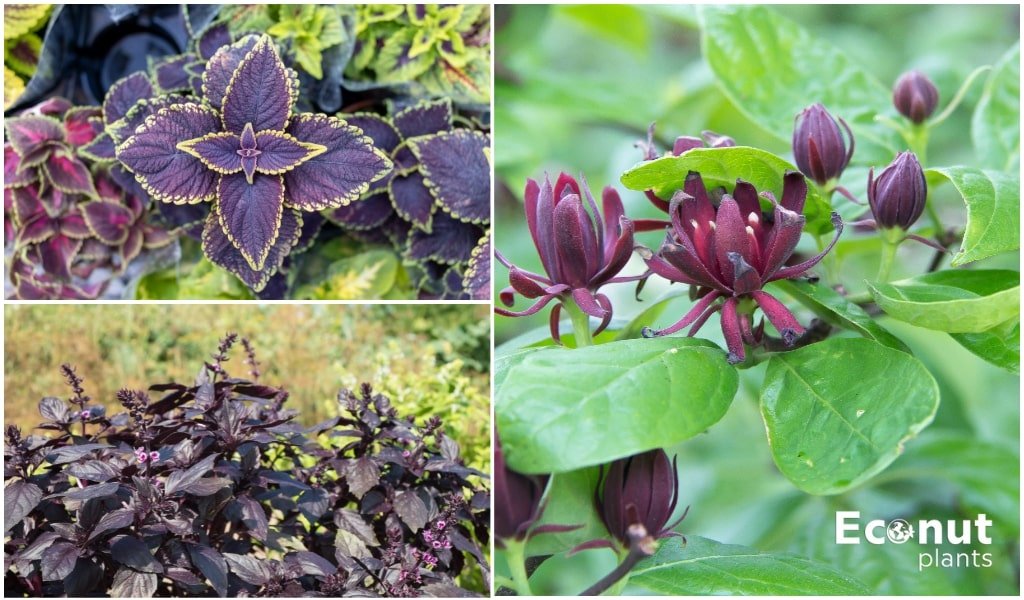Even out of flower, purple-leafed plants bring colour, texture, and variety to your landscape all through the growing season and beyond. Flowers are beautiful in and of themselves, but they can be ephemeral, so it’s always a good idea to fill in any colour gaps with colourful foliage plants. Offers her favourite plants with purple foliage in this article!
1. Purple Basil

Botanical Name: Ocimum basilicum
Plant Type: Annual
Sun Exposure: Full Sun
Water Needs: Medium
Among the most popular plants for summer is basil. It is readily cultivable from seed or can be bought as a little bedding plant. Warm summer conditions are ideal for basil growth; it dislikes cold weather.
Plant it in a full-sun, well-drained spot with rich, moist soil. Basil is a plant that does well in pots and can be used in vegetable, herb, pollinator, or annual flower gardens.
Though there are purple variations as well, the leaves of basil plants are usually bright green. Depending on the species and amount of sunshine the plant receives, leaves can range in colour from a light purple-green to a deep, velvety crimson.
2. Purple Leaf Plum
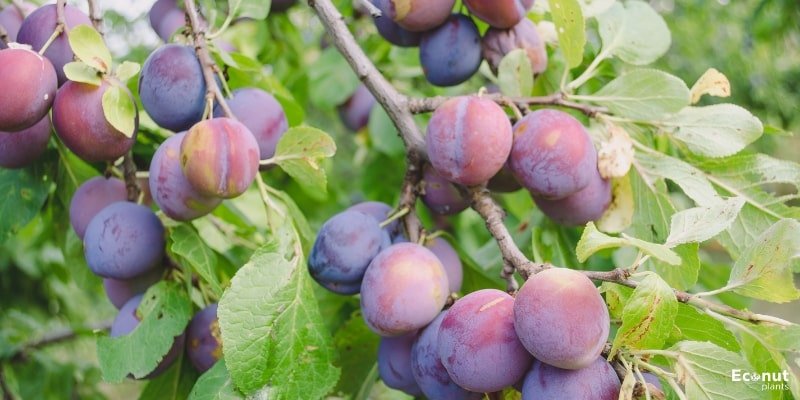
Botanical Name: Prunus cerasifera
Plant Type: Tree
Sun Exposure: Full sun to part shade
Water Needs: Medium
The purple-leaf plum, commonly known as the cherry plum, is an ornamental fruit tree that blooms in the spring and has lovely pink blossoms with five petals.
Bees and other pollinators are drawn to the flowers. Despite their profusion of blossoms, ornamental plum trees don’t usually bear fruit. If the tree bears fruit, it will produce tiny, tasty purple fruits that also attract birds.
Throughout the growing season, the leaves maintain a purplish-green colour. Although they may withstand some shade, plum trees thrive best in direct sunlight. Rich, wet, and well-drained soil is ideal. To keep your plum tree growing consistently, prune it.
3. Purple Lettuce
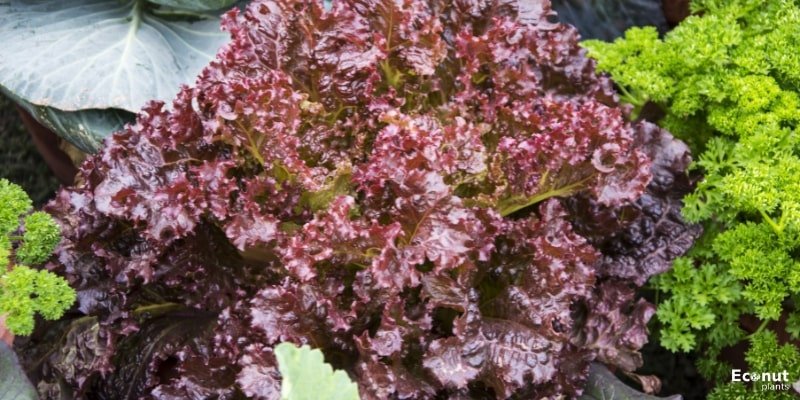
Botanical Name: Lactuca sativa
Plant Type: Annual
Sun Exposure: Full sun to part shade
Water Needs: Medium
Lettuce grows quickly and easily. Plant some purple lettuce in the spring or autumn if you want to add a little something different to regular green lettuce.
Although purple-leaved lettuce is available in several kinds, the majority will have a blend of green and purple leaves. For instance, some cultivators have green leaves with purple specks, while other cultivators have nearly all maroon foliage.
Although you may purchase lettuce as a bedding plant, growing it from seed will give you a much wider variety. When the weather gets too warm, lettuce bolts. It grows best in the cooler months. In the garden, lettuce may be grown almost anywhere, or for a fast splash of colour, outside, in a huge container.
4. Purple Velvet Plant

Botanical Name: Gynura aurantiaca
Plant Type: Houseplant
Sun Exposure: Full sun to part shade
Water Needs: Medium
A popular houseplant, the purple velvet plant is a broadleaf perennial that is evergreen. It grows easily in wet soil with filtered sunshine as a houseplant.
Take cuttings to propagate, which can then be placed outside for summer container gardens. By taking new cuttings every winter, the plants can be kept alive.
It’s a well-titled purple velvet plant. Bright green leaves are veiled in silky, velvety purple fuzz. Purple fuzz covers the stems as well, giving the entire plant a very delicate appearance.
Velvet plants can be kept compact by pruning them as needed. Because they spread out easily, plants would look good in a hanging basket or other container where they could dangle over the side.
5. Red Leaf Cordyline
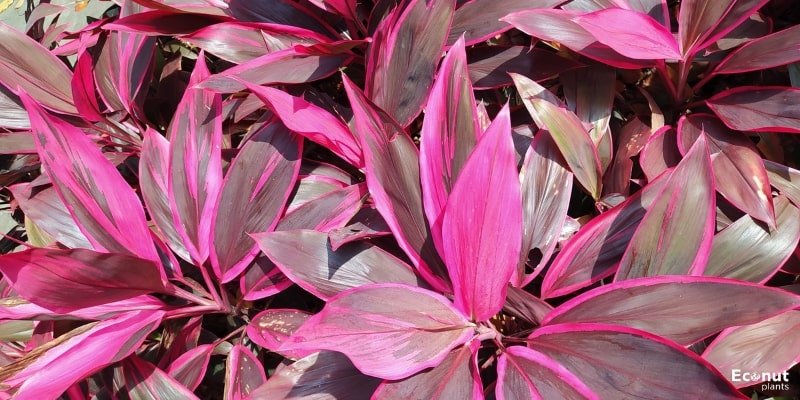
Botanical Name: Cordyline fruticosa ‘Rubra’
Plant Type: Houseplant
Sun Exposure: Full sun to part shade
Water Needs: Medium
The plant cordyline with crimson leaves is striking. It can reach the size of a small tree in its natural tropical habitat, but it won’t get as big as a houseplant.
A cultivar of green, widely lance-shaped leaves that have a brilliant lavender-pink hue is called red leaf cordyline. This plant would make a gorgeous accent in a larger, brighter interior room.
For optimal appearance, red leaf cordyline needs bright, indirect sunshine. It also requires a warm, consistently humid area; otherwise, the leaves tend to get brown and dry. Except for a brief respite with a bit less water in the winter, the soil should be kept consistently moist.
6. Royal Purple Smokebush

Botanical Name: Cotinus coggygria ‘Royal Purple’
Plant Type: Deciduous shrub
Sun Exposure: Full sun
Water Needs: Medium
This beautiful shrub is a wonderful way to bring variety and colour to the landscape. The term “smokebush” comes from the seed clusters that grow after flowering and have a hazy or smoky appearance.
The purple-green leaves of the royal purple smokebush become vivid colours of crimson and orange in the autumn, adding a great deal of interest to the plant all during the growing season.
The ideal growing conditions for smokebush are bright, well-drained soil and a sunny spot. Your smokebush can get rather big, so give it lots of space to grow. Use this pretty shrub as an accent plant on its own or as a component of a hedge row.
7. Wandering Jew

Botanical Name: Tradescantia zebrina
Plant Type: Houseplant
Sun Exposure: Full sun to part shade
Water Needs: Medium
A common plant, wandering jew is also known as small-leaf spiderwort. It is more commonly known as a houseplant in temperate zones, even though it is an herbaceous perennial in tropical climates. During the summer, it can be cultivated outside. Use moist, well-drained soil and a sunny window for your houseplant.
The leaves of the wandering Jew are really pretty. The long, creeping stems that the leaves grow along are perfect for creating a ground cover in a pot or planter.
On the upper surface, leaves have stripes of green, silver, and maroon; beneath, they have deep maroon stripes. Purple leaves in a solid colour are seen in other types. Stem cuttings are an easy way to grow these plants.
8. Rex Begonia
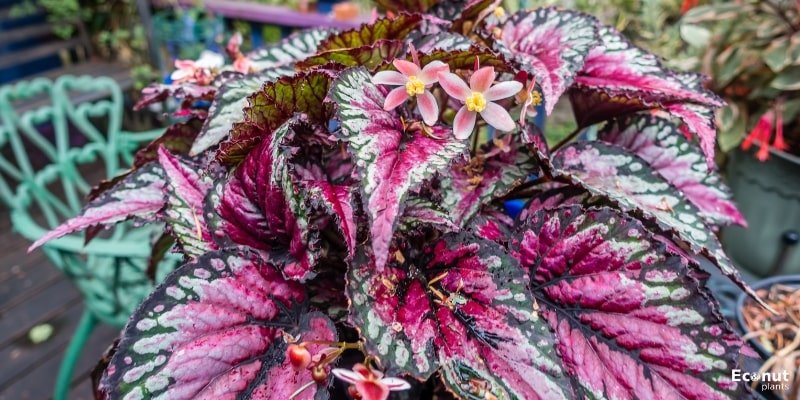
Botanical Name: Begonia spp.
Plant Type: Houseplant
Sun Exposure: Full sun to part shade
Water Needs: Medium
The Rex begonia is an herbaceous perennial in its natural jungle home, but it is more frequently grown as a houseplant in temperate climates.
The majority of Rex Begonia cultivars thrive in filtered sunshine and can be planted outside in a cool spot during the summer. Bring it indoors for the winter or overwinter cuttings.
The gorgeous foliage of the Rex begonia is well known. The colours of the leaves include green, crimson, purple, bronze, and silver. Even within a single plant, there can be a great variation in leaf colour. Begonia hybrids and cultivars abound as well, many of which have eye-catching, vividly coloured leaves.
9. Purple Waffle Plant

Botanical Name: Hemigraphis alternata
Plant Type: Herbaceous perennial
Sun Exposure: Full sun to part shade
Water Needs: Medium
The most popular way to grow the herbaceous perennial purple waffle plant is as an annual. The reddish-brown stems and burgundy undersides of the leaves give them a silvery-green appearance. This plant’s distinctive colour blends well with any surrounding greenery.
The purple waffle plant grows well in containers and is best cultivated as a ground cover in a moderately shaded area.
By taking cuttings of plants before the first frost and rooting them indoors, plants can be overwintered. These can be planted outside in the spring after being grown indoors during the winter.
10. Purple Shamrock

Botanical Name: Oxalis triangularis
Plant Type: Bulb
Sun Exposure: Full sun to part shade
Water Needs: Medium
Most people probably associate purple shamrock with warmer climates, where it is used as a perennial bedding plant. Growing it as a houseplant is likewise a breeze.
Take note that if ingested in large numbers, this plant may be hazardous to humans and dogs. Although it does not need direct sunshine to flourish, purple shamrock should be grown in soil that is well-drained, wet, and brightly lit.
Low-growing plants that resemble clover are called purple shamrocks. In the spring, it bears exquisite pink blooms and has shimmering purple, three-part leaves. Grow this outdoors in a container, and bring it inside for the winter in a cool, dark spot until springtime. It has great ground cover qualities when grown outside.
11. Purple Sea Holly

Botanical Name: Eryngium planum
Plant Type: Herbaceous perennial
Sun Exposure: Full sun
Water Needs: Dry
When in full bloom, purple sea holly is an impressive sight. The broad, primarily green basal leaves change to vibrant lavender-purple stems in the summer as the plant grows flower stalks.
In addition to being vivid purple with touches of green, the flower bracts and blooms are spiky. Not only will these striking flowers draw a lot of attention, but bees, butterflies, and other pollinators will also like them.
A lengthy tap root is developed by the perennial purple sea holly. It can withstand droughts pretty well once it gets established. With time, this plant will become rather bushy and spread slowly, so provide it with lots of area to grow in a sunny spot. It looks spectacular when grown in groups!
12. Purple-leaf Sand Cherry
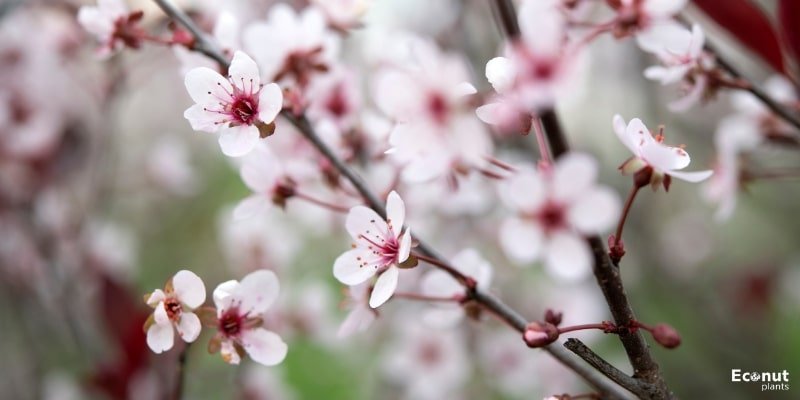
Botanical Name: Prunus x cisterna
Plant Type: Deciduous shrub
Sun Exposure: Full sun
Water Needs: Medium
Native to North America, the sand cherry is a tiny shrub. Variations in leaves, flowers, and fruits have been produced in cultivars and hybrids. The hybridized purple-leaf sand cherry has green to reddish-purple leaves. From April until autumn, the leaves maintain their vibrant hue.
The purple-leaf sand cherry blooms small, five-petaled white flowers with deep crimson centers in clusters in the spring. Pollinators are drawn to flowers because of their slight fragrance.
Birds also love the few fruits that this sand cherry can produce. Sand cherry is a medium-sized accent plant that looks great in a sunny spot, or it can be a colourful addition to a hedge.
13. Purple Kale
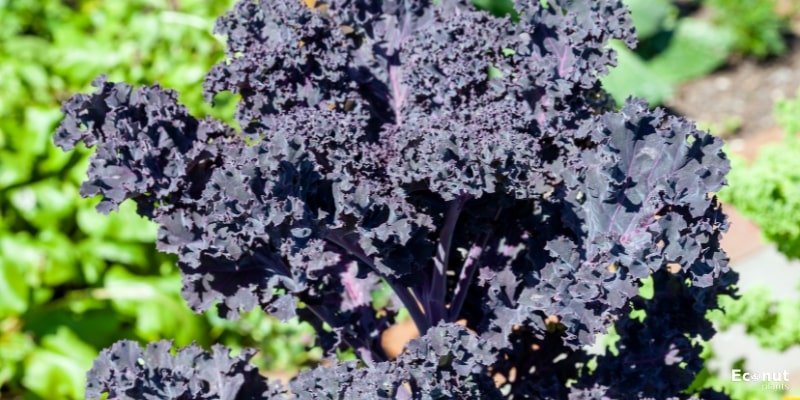
Botanical Name: Brassica oleracea ‘Redbor’
Plant Type: Annual
Sun Exposure: Full sun
Water Needs: Medium
Purple kale is a stunning and delectable vegetable. This eye-catching green vegetable can be planted in a big container or the vegetable garden; for some intriguing variation, you can even add it to your flower garden!
Growing kale is simple during the colder months. If it becomes too hot, kale will bolt and send up flower stalks, so cultivate it mostly in the spring and autumn.
A visually appealing plant for the home garden is purple kale. It is readily cultivated from seed or bought at many garden centres and nurseries. The leaves are usually somewhat ruffled around the edges and have a purplish-green colour. Their vivid lavender-purple stems and veins give them a striking colour.
14. Eastern Ninebark ‘Diablo’

Botanical Name: Physocarpus opulifolius ‘Diablo’
Plant Type: Deciduous shrub
Sun Exposure: Full sun
Water Needs: Dry to medium
Native to eastern and central North America, the eastern ninebark is a medium-sized shrub. The ‘Diablo’ cultivar features purplish-green leaves that deepen in colour to purple when planted in areas with more shade.
Blooms in the springtime in large, semi-spherical clusters of white blooms. From a distance, the clusters of flowers look like snowballs balanced between the leaves.
Low-maintenance eastern ninebark is a great shrub to plant as a hedge or to minimize erosion next to a stream.
Ninebark grows well in many types of soil and lighting. Plants can be pruned to retain a more compact shape if desired, although they usually have long, leafy branches that shoot out in all directions.
15. Dahlia ‘Bishop of Oxford’
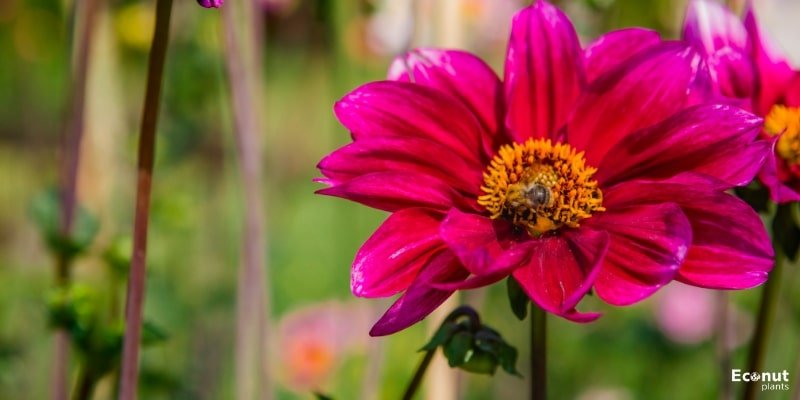
Botanical Name: Dahlia ‘Bishop of Oxford’
Plant Type: Herbaceous perennial
Sun Exposure: Full sun
Water Needs: Dry to medium
Dahlias are a timeless classic flower for gardens, and many new kinds are being created all the time. ‘Bishop of Oxford is an intriguing cultivar with eye-catching purple-green leaves that make a lovely contrast to the enormous coral-pink flowers. Dahlias are an excellent option for your floral arrangements if you enjoy long-lasting cut flowers!
Although they can withstand some shade, dahlias prefer full sun, especially in regions with hot summers. Rich, well-drained soil that is continuously moist is necessary for dahlia growth. They cannot withstand drought or dry soil. Up to the first frost, a robust plant can virtually always be in flower throughout the summer.
16. Crabapple ‘Cardinal’
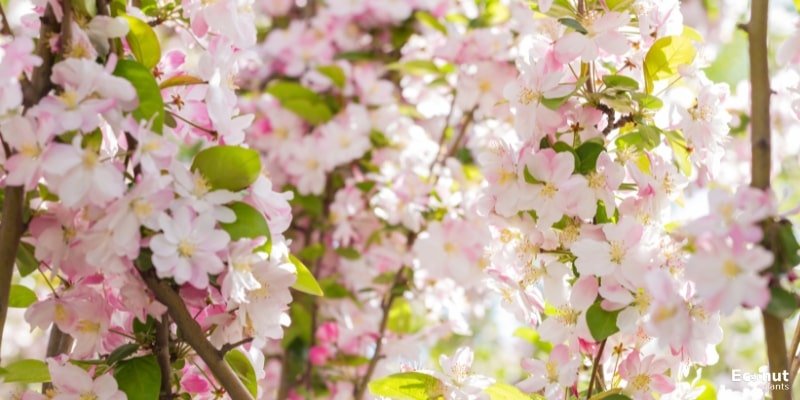
Botanical Name: Malus ‘Cardinal’
Plant Type: Tree
Sun Exposure: Full sun
Water Needs: Dry to medium
Crabapples come in a wide variety of commercial kinds. ‘Cardinal’ is one of several cultivars whose leaves range in colour from purple to bronze. Throughout the growing season, the striking purple-green leaves of this cultivar are visually appealing.
The enormous quantity of exquisite pink blossoms that blanket the tree every spring, however, is the true show-stopper. There’s also the vibrant autumn foliage to be grateful for.
Plant your “Cardinal” crabapple in a sunny spot. Rich, wet, and well-drained soil is ideal. To keep your crabapple tree more compact and to get rid of any dead branches, prune it in late winter. Butterflies and birds will be drawn to flowers and fruits.
17. Coleus
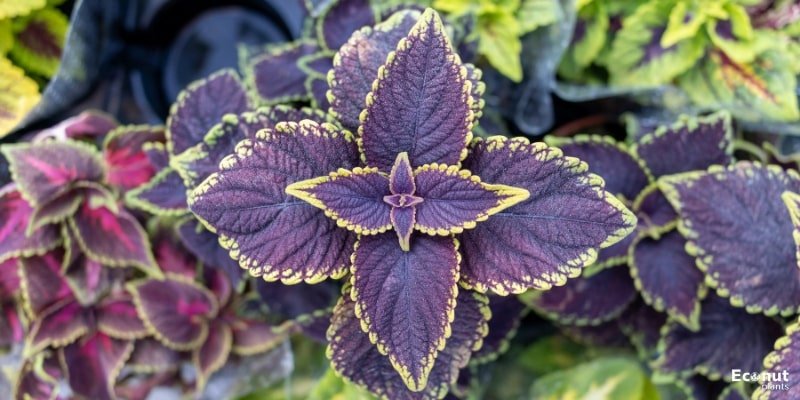
Botanical Name: Coleus
Plant Type: Annual
Sun Exposure: Full sun to part shade
Water Needs: Dry to medium
One common annual garden plant is coleus. It can be cultivated from seeds sown in the spring, cuttings, or readily available small bedding plants.
Coleus is most valued and well-known for its incredibly variegated leaves, which come in a rainbow of colours. Coleus plant comes in a wide range of vibrant colours, such as pink, purple, burgundy, and maroon. A plant that grows well in both full and partial sun.
If the plants become too lanky, prune them to maintain their business. If you would like to maintain a more rounded appearance for your plants, you may also trim off the little flower spikes.
Take cuttings of your favourite plants that you want to keep going over the winter and grow them indoors so you can replant them outside in the spring.
18. Canna ‘Australia’
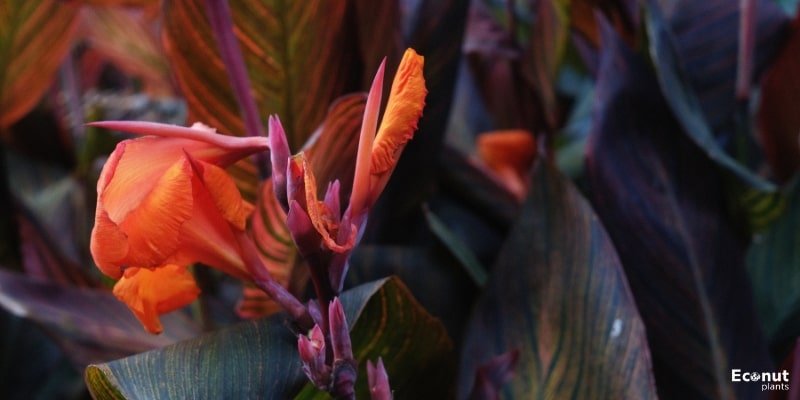
Botanical Name: Canna x generalis ‘Australia’
Plant Type: Bulb
Sun Exposure: Full sun
Water Needs: Medium
The canna ‘Australia’ has broad burgundy leaves with red blooms, but many cannas have green foliage with red, yellow, or orange flowers. Cannas are common garden plants in the Southeast. In milder climates, plants can be simply grown in containers and taken indoors to overwinter in a cool, dark place.
Rich, well-drained soil and a sunny location are ideal for canna cultivation. With huge, opulent flower stalks, plants can get fairly tall.
The vibrantly coloured leaves of “Australia” are stunning on their own, even without flowers. When planted in a cluster, this plant looks good and would make a great accent plant.
19. Bok Choy

Botanical Name: Brassica rapa
Plant Type: Annual
Sun Exposure: Full sun to Partial Shade
Water Needs: Medium
A well-known garden vegetable produced for its crunchy leaves is bok choy, also known as pak choy. Certain types maintain their green colour throughout, while others have lovely purple foliage paired with green stems.
Bok choy is a quick-growing crop that fills in gaps in a spring vegetable garden in an edible way. It produces a stalk of tiny yellow blossoms if allowed to flower.
A vegetable for the cool season is bok choy. It grows readily from seed in the early spring or autumn. As long as the air temperature isn’t too hot, it thrives in full sun; otherwise, it will bolt rapidly.
Its growing season may be somewhat extended by growing in partial shade. At every stage of its growth cycle, bok choy can be consumed raw or cooked.
20. ‘Blue Hawaii’ Elephant Ear

Botanical Name: Colocasia esculenta ‘Blue Hawaii’
Plant Type: Bulb
Sun Exposure: Full sun to Partial Shade
Water Needs: Medium
The ‘Blue Hawaii’ elephant ear plant is easily identified by its characteristic leaves. They have big, noticeable purple veins on a bright green background. Not only are they enormous, but they are also incredibly colourful! Massive, heart-shaped leaves that grow singly atop strong, durable stems can reach a length of one foot.
The elephant ear of “Blue Hawaii” emerges from a big bulb. Rich, wet, well-drained soil is ideal for their growth. Plants in zones 7 through 10 can survive the winter outdoors.
If you reside in a region with a cooler climate, digging up the bulbs every autumn and storing them in a cool, dark place over the winter will not be difficult. You can then plant the bulbs outside every spring.
21. Black Rose Aeonium
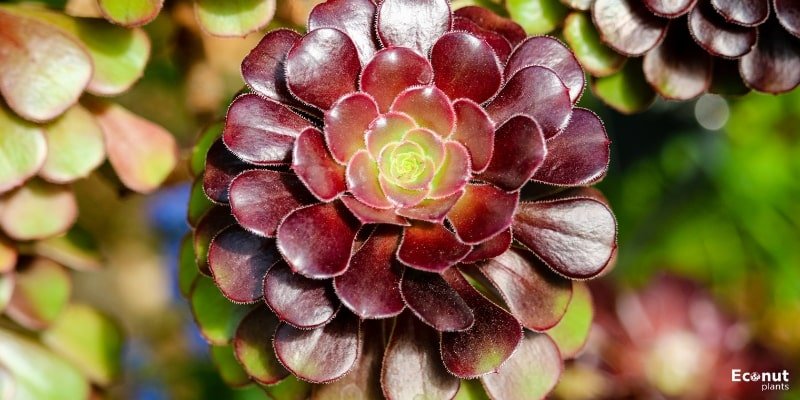
Botanical Name: Aeonium arboreum ‘Zwartkop’
Plant Type: Succulent
Sun Exposure: Full sun
Water Needs: Dry to Medium
The beautiful black rose Aeonium is a kind of succulent plant with purplish-green foliage. When grown in a large pot in a sunny, warm greenhouse, this plant can grow stems several feet tall with dark reddish-purple foliage, but it tends to stay quite tiny when kept as a houseplant in regular indoor settings.
A young plant will resemble a rosette of succulent leaves that is growing toward the ground. It will grow a stalk as it expands. New leaves will keep appearing from the top as the lower leaves wither away. Usually, more developed plants will develop a few side-branching stalks, each with a leafy rosette at the apex.
22. African Milk Tree

Botanical Name: Euphorbia trigona ‘Rubra’
Plant Type: Succulent
Sun Exposure: Full sun
Water Needs: Low
A huge upright succulent, the African milk tree can reach up to six feet in height under the correct circumstances. Load the soil with cacti and allow it to drain adequately. Provide ample amounts of direct sunshine. Because plants can quickly experience root rot and die, cacti and succulents should not be overwatered.
A colourful variety is the African milk tree known as “Rubra.” With pointed leaves and sharp spines on each of the three outside edges of each tall, triangular stalk, this plant grows them.
The leaves and spines have vibrant colours of pink, green, and maroon, while the fleshy stems are speckled green-pink. An expansive, well-lit space would benefit greatly from the striking appearance of this plant!
23. Astilbe ‘Delft Lace’
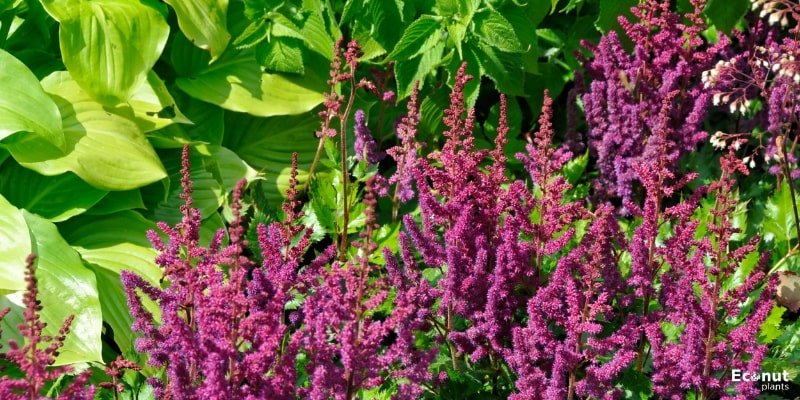
Botanical Name: Astilbe ‘Delft Lace’
Plant Type: Herbaceous perennial
Sun Exposure: Full sun
Water Needs: Medium
The genus Astilbe contains a wide variety of exquisite species. ‘Delft Lace’ features vivid pink blooms and reddish-purple leaves, but these plants usually have slightly fern-like green leaves.
Plants are a great addition to a shade garden since they thrive in areas with lots of shade. When exposed to intense heat and direct sunlight, leaves typically wither by late summer and go dormant until the following spring.
Astilbe plants are valued perennials due to their hardiness, beauty, and ability to draw a large number of pollinators with their blossoms. In addition, these plants are resistant to deer and rabbit browsing. Rich, moist soils with good drainage are ideal for their growth.
To help keep them healthy and developing until the end of the season, water them frequently during the hottest summer months. The plants may die back too soon if it gets too hot or dry, but they should come back next spring.
24. ‘Black Scallop’ Bugleweed
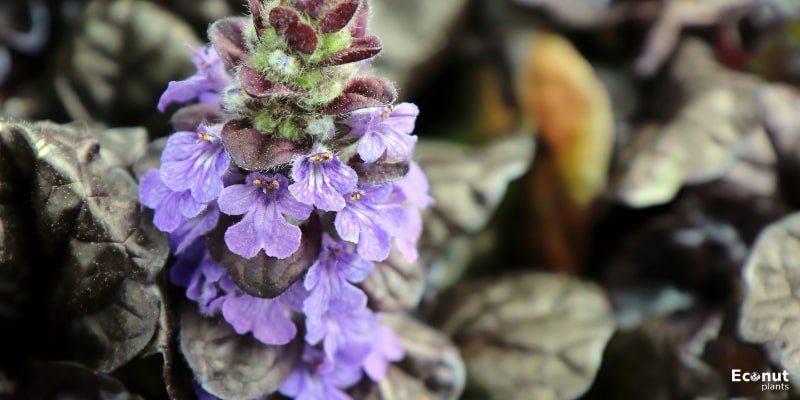
Botanical Name: Ajuga reptans ‘Black Scallop’
Plant Type: Herbaceous perennial
Sun Exposure: Full sun
Water Needs: Medium
A great option for a flowering ground cover plant is bugleweed. It will spread quickly to cover bare areas of the ground, like edges, borders, and walkways.
Before planting bugleweed (Ajuga reptans), please make sure it is not included in your state’s list of invasive species. This is because it is listed as an invasive species in some states.
The leaves of several bugleweed cultivars have a faint purple tint. The leaves of the ‘Black Scallop’ type can be green, purple-veined, or a deep dark purplish-black colour, depending on how much sunlight the plant gets. Except for occasional pruning, this plant requires little care and grows well in a variety of light and soil conditions.
25. Boat Lily
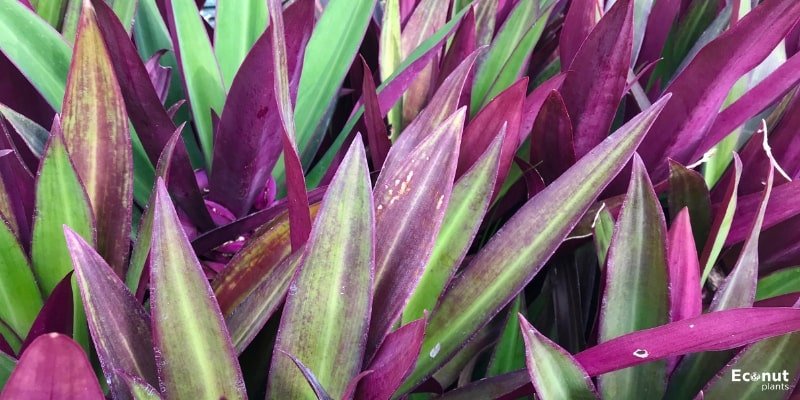
Botanical Name: Tradescantia spathacea
Plant Type: Herbaceous perennial, Houseplant
Sun Exposure: Full sun
Water Needs: Medium
The boat lily, popularly known as Moses-in-a-basket, is a common houseplant yet can withstand tropical winters.
Even though it is grown indoors, it may be brought indoors for the winter in a container and set outside in the summer. Cuttings can also be taken to proliferate over the winter.
The boat lily grows rather compactly when planted in bright light. Growing on stems that can creep down the ground to cover the ground or drape over the edges of a container, oblong, tapering leaves grow. The undersides and stem have a deep purple colour, whereas the leaf surfaces are usually a vivid green colour.
26. Burgundy Lace Fern

Botanical Name: Athyrium niponicum ‘Burgundy Lace’
Plant Type: Fern
Sun Exposure: Full sun
Water Needs: Medium
A shady garden is a great place for ferns. The burgundy lace fern features silvery-green leaves with purple highlights, veins, and stems, in contrast to most ferns, which have gorgeous green foliage. Any other plants growing nearby would look good with the burgundy lace fern’s vibrant fronds.
Planting this fern in a shaded spot beneath neighbouring trees or shrubs might be a good idea. To enjoy this beautiful plant, put it by a stream or next to a shady outdoor seating spot.
The ideal soil is wet and has good drainage. Insect pests, deer, and rabbits don’t bother ferns, making them generally low-maintenance garden additions.
27. Burgundy Spice Sweetshrub
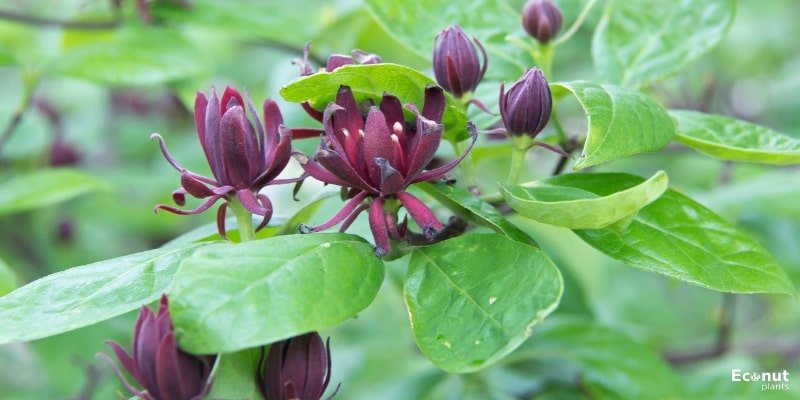
Botanical Name: Calycanthus floridus ‘Burgundy Spice’
Plant Type: Deciduous shrub
Sun Exposure: Full sun to Part Shade
Water Needs: Medium
A native of the Southeast of the United States, burgundy spice sweet shrub is a cultivar of allspice. The leaves of burgundy spice sweet shrub vary from being primarily green with hints of purple to being intensely burgundy with green veins.
This shrub’s appeal is enhanced by the differences in colour among its leaves. Before falling for the winter, the foliage transforms into stunning tones of gold and orange throughout the autumn.
Spring brings flowering times that extend throughout midsummer. The flowers are aromatic, large, and have a rich reddish-burgundy colour. Though adaptable to many different soil types, this plant thrives in rich, moist soil in a somewhat shaded area.
28. Chinese Fringe Flower

Botanical Name: Loropetalum Chinese
Plant Type: Broadleaf evergreen
Sun Exposure: Full sun to Part Shade
Water Needs: Medium
A shrub that adds year-round appeal to the home landscape is the Chinese fringe flower. The plant’s leaves, which range in hue from burgundy-green to burgundy-red, are present all year. The shrub is covered in brilliant pink or red hanging flowers that resemble fringes in the springtime.
Compared to plants cultivated in shadier areas, those planted in sunny areas typically have more colourful foliage and more blossoms.
This would be a great addition to a hedge or shrub border or used as a larger accent plant on its own. Although it’s not required, you can prune to keep size and form.
29. Coral Bells ‘Midnight Rose’

Botanical Name: Heuchera ‘Midnight Rose’
Plant Type: Herbaceous perennial
Sun Exposure: Full sun to Part Shade
Water Needs: Medium
One common perennial plant for gardens is coral bells. Numerous heuchera varieties, such as “Midnight Rose,” are available with exquisitely coloured foliage. The leaves of this cultivar vary greatly in colour from plant to plant.
The leaves can have a rich, solid burgundy-red underside and a dusky green top with specks of pink, silvery-grey, and other colours. Other plants have burgundy hues dominating, with bits of grey and green. In any case, the foliage is stunning!
When combined with different types of coral bells or other mixed perennials, coral bells produce beautiful clumps. It is a good ground cover or edging plant because of its low growth rate. Over time, clusters can be readily regulated to stop growing too much. They will either self-seed or be spread by runners.
30. Echeveria ‘Afterglow’

Botanical Name: Echeveria ‘Afterglow’
Plant Type: Succulent
Sun Exposure: Full sun
Water Needs: Low
In warmer climates, you can grow the succulent Echeveria ‘Afterglow’ as a houseplant or in a rock garden. Grow echeveria indoors under grow lights or in the brightest spot possible for a houseplant.
Over the summer, you can move them outside to grow in a container and then bring them inside before the first frost.
Echeveria is a leafy, tight rosette that grows. The ‘Afterglow’ cultivar features exquisitely coloured leaves that transition from vivid pink to a blue-green hue containing varying tones of purple.
Ensure that the soil in which you plant any echeveria is well-drained to prevent them from sitting in moisture. With time, plants spread out and become a great ground cover.
31. Hens and Chicks ‘Purple Haze’

Botanical Name: Sempervivum heuffelii ‘Purple Haze’
Plant Type: Succulent
Sun Exposure: Full sun
Water Needs: Low
A unique succulent that thrives in temperate areas are hens and chicks. This plant looks great in containers, along borders and edges, in xeriscapes, or a rock garden or desert garden. Raise chickens and chicks in soil that is loose and well-drained in full light.
Tight, leafy rosettes cover the ground densely when hens and chicks are around. More mature plants produce new, tiny rosettes to colonise an area, which is how rosettes spread.
You can just divide up new plants to multiply them if you’d like, or you can just let them grow where they are. Certain types have green leaves; some have green leaves with purple tips, while others have purple leaves completely.
32. Ornamental Cabbage
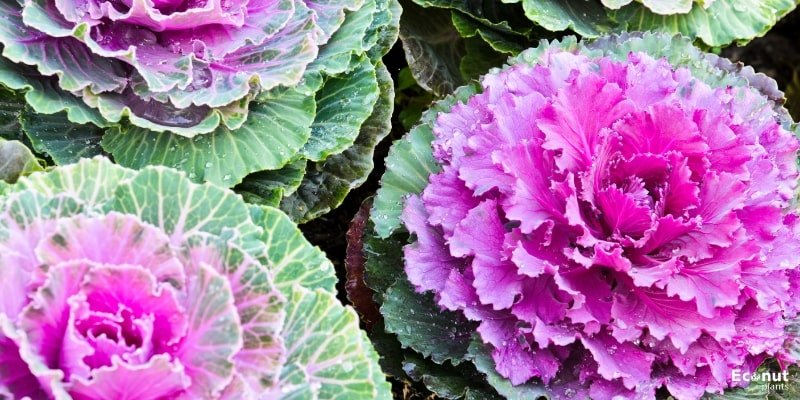
Botanical Name: Brassica oleracea
Plant Type: Annual
Sun Exposure: Full sun
Water Needs: Medium
The majority of decorative cabbages are cultivated for their vibrant foliage, which comes in pink, purple, and white tones. Nurseries and garden centers are great places to find plants, and they can also be started from seed.
Although they can withstand a little afternoon shadow during the hottest summer months, they grow best in full sun. They grow best in the spring and autumn as ornamental plants in warmer areas. Fall-planted decorative cabbages will withstand multiple frosts and retain their attractive appearance far into the early winter months.
Gardeners can use decorative cabbages for a variety of purposes. They grow well in containers and can be used as a border, planted with annuals or perennials, or grown in an herb garden. Use well-drained, rich, and wet soil.
33. Ornamental Pepper ‘Purple Flash’

Botanical Name: Capsicum annum ‘Purple Flash’
Plant Type: Annual
Sun Exposure: Full sun
Water Needs: Medium
The decorative pepper is no different from other pepper plants that grow nicely in warm summer garden settings. These plants may be grown from seed with ease, and garden centers occasionally sell them as bedding plants.
Peppers are essentially herbaceous perennials in tropical regions, but they are planted as annuals in much of the United States.
An ornamental pepper variant called “Purple Flash” is more compact and smaller. With some white highlights, the leaves have a vivid purple-green hue. Additionally, the plants yield purple blooms.
The spherical, tiny pepper fruits have a nearly purple-black hue and are very spicy. These ornamental pepper plants make stunning additions to herb gardens and seasonal flower gardens, and they work well in containers.
34. Polka Dot Plant

Botanical Name: Hypoestes phyllostachya
Plant Type: Annual
Sun Exposure: Full sun
Water Needs: Medium
The polka dot plant is most usually planted as an annual in the United States; however, it is an herbaceous perennial. However, if you reside in a tropical region, you can grow this plant outside all year.
The ideal growing conditions for polka dot plants are shade and rich, moist soil. It can be used in container gardening or grown as a bedding plant. Plants can be cultivated indoors in pots, overwintered, or replanted the following spring from cuttings that root indoors.
You won’t quickly forget polka-dot plants once you see them. The entire surface of the vibrant green leaves of these lush tropical plants is speckled with brilliant pink splotches.
The vibrant foliage truly makes a statement in any kind of garden. Pinch back stems occasionally to keep plants compact and bushy if they start to get lanky.
35. Purple Ground Clematis

Botanical Name: Clematis recta ‘Purpurea’
Plant Type: Herbaceous perennial
Sun Exposure: Full sun
Water Needs: Medium
Purple ground clematis is a bit different from the common clematis, which is most commonly known for its enormous, showy flowers and vine-like habit. With 2- to 4-foot branches that can be staked erect or allowed to sprawl as a ground cover, this herbaceous perennial clematis is a sight to behold.
Depending on the season and amount of sunlight, the leaves’ hue changes from green to pale purple. White blooms with a delicate scent grow from late spring to midsummer.
This plant can withstand some afternoon shadow, but it thrives in full sun. During the growing season, clematis prefers rich, well-drained soil that remains consistently moist and chilly.
This clematis can be trained to grow alongside a fence, planted as a ground cover, or added to a pollinator garden where the blooms will attract butterflies and bees.
36. Purple Leaf Weigela

Botanical Name: Weigela Florida ‘Wine u0026amp; Roses’
Plant Type: Deciduous shrub
Sun Exposure: Full sun
Water Needs: Medium
A sunny border or hedge row might benefit from the low-maintenance shrub weigela. The purplish-green foliage of the purple leaf weigela ‘Wine & Roses’ would go well with any other plants in the vicinity.
“Wine & Roses” attracts hummingbirds with its loose clusters of colourful, pink flowers that bloom in the spring.
Weigela can be grown in bright sunlight or partial shade. The ideal soil has a medium moisture content and good drainage. Just after flowering, trim plants into the appropriate shape if they begin to look scraggly.
Pruning at the right time of year can enhance the possibility of flowers the following year since flowers grow on old wood rather than new growth.
37. Stonecrop ‘Purple Emporer’

Botanical Name: Stonecrop ‘Purple Emporer’
Plant Type: Succulent herbaceous perennial
Sun Exposure: Full sun
Water Needs: Low
Stonecrop is a succulent that grows easily in almost any sunny spot with well-drained soil. Grown in a mixed container garden, this plant would look great as an accent in a perennial border or rock garden. Cuttings of rooted stems are a simple way to propagate plants.
A variety of stonecrop called “Purple Emporer” has purple leaves. Growing in partial shade causes the leaves to turn paler purple and green while growing in the full sun causes them to turn a deep, dark burgundy. Midsummer sees the blooming of striking clusters of maroon-pink flowers that draw butterflies and hummingbirds.
38. Purple Heart Plant
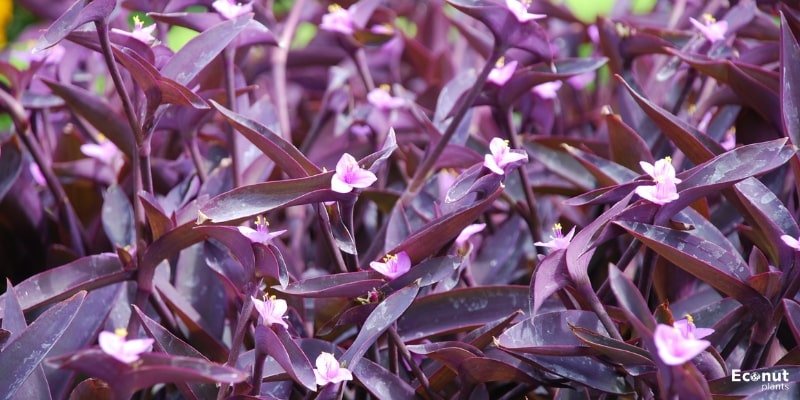
Botanical Name: Tradescantia pallida ‘Purpurea’
Plant Type: Annual
Sun Exposure: Full sun
Water Needs: Medium
The Purple Heart plant grows trailing stems with oblong, pointy leaves that are highly purple in colour. This plant grows well in a container, along a wall where it can spill over the edge, or as a ground cover. Randomly spaced along the stems are pink flowers with three petals.
In tropical areas, this plant is an herbaceous perennial. It can easily be grown as an annual or houseplant in other places.
Stem cuttings are a great way to start plants, and you can easily overwinter numerous cuttings indoors to replant in the spring.
39. Persian Shield

Botanical Name: Strobilanthes dyerianus
Plant Type: Annual
Sun Exposure: Full sun to Part Shade
Water Needs: Medium
The ideal way to cultivate a Persian shield is as an annual in the summer garden. It grows from seed or cuttings but is also occasionally sold as a bedding plant.
Annual plants growing outside can be brought inside for the winter in containers. Additionally, you can take autumn cuttings from outdoor plants, allow them to root over the winter, and then replant the rooted cuttings outside in the spring.
The ideal soil for Persian shield Plant growth is rich, wet, and well-drained. In temperate climates, it can be grown in full sun, but in warmer climates, it prefers some afternoon shade.
Grown in outdoor containers or on borders, this is a great bedding plant. You can even grow it indoors as a houseplant if you have a suitable sunny window!
40. Ornamental Millet ‘Purple Majesty’
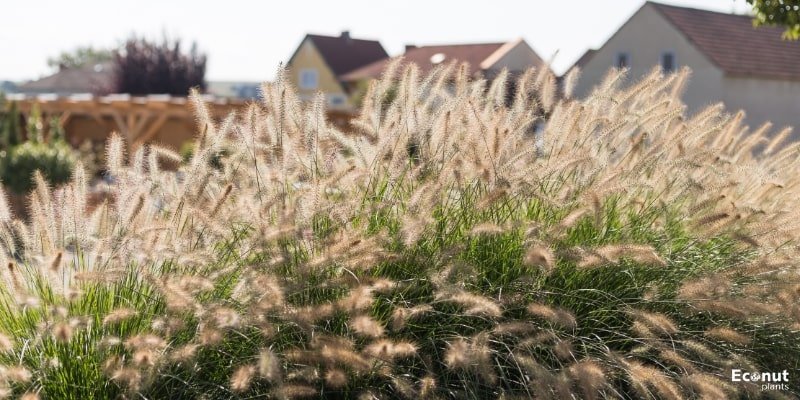
Botanical Name: Pennisetum glaucum ‘Purple Majesty’
Plant Type: Annual
Sun Exposure: Full sun
Water Needs: Medium
‘Purple Majesty’ ornamental millet is a type of grass. Its long, narrow, downward-curving purple-green leaves are borne on tall, robust stalks.
It grows a highly spectacular inflorescence that resembles a thick purple-to-white bottle brush from mid-summer to early autumn. Grown in clusters, “Purple Majesty” looks best since the tall plants can support one another and make a significant statement against the background.
Growing ornamental millet from seed is simple. Plants grow quickly and resemble purple-leaved maize stalks in certain ways. Grow it in well-drained, wet soil in full sun. The ripe seeds will attract birds in mid-to late fall.
41. Japanese maple

Botanical Name: Acer palmatum
Plant Type: Tree
Sun Exposure: Full sun to Part Shade
Water Needs: Medium
Japanese maples come in a wide range of sizes, growing environments, leaf shapes, and colours. During the growth season, numerous cultivars have leaves that are reddish-purple in colour. produce vivid, varied, and incredibly striking autumn leaves in late autumn, with tones of crimson, orange, purple, and bronze.
Japanese maples are charming little trees that look well in backyard landscaping. Although they do best in full sun, they also tolerate some shade, especially in the warmer parts of their habitat.
Rich soil that drains properly is ideal for growing them. These trees are typically cultivated as ornamentals and simply require pruning to get rid of dead branches.
42. Flowering Dogwood ‘Purple Glory’

Botanical Name: Cornus Florida ‘Purple Glory’
Plant Type: Tree
Sun Exposure: Full sun to Part Shade
Water Needs: Medium
The leaves of the dogwood variety known as “Purple Glory” range in colour from light greenish-purple to deep maroon, and they turn dark purple in the autumn. Springtime blooms are voluminous, with a deep, vintage rose hue. Trees bear red berries in early autumn, which draw a variety of birds.
The ideal growing conditions for flowering dogwood are medium-moisture soil and some shade. To help keep roots moist during the summer, apply a protective layer of mulch.
Dogwoods are lovely and practical trees, so even if they are prone to many fungal diseases and insect pests, they might still be worth adding to the home landscape.
43. Coral Bells ‘Forever Purple’

Botanical Name: Heuchera ‘Forever Purple’
Plant Type: Herbaceous perennial
Sun Exposure: Full sun to Part Shade
Water Needs: Medium
Coral bells come in a variety of a variety, one of which is called “Forever Purple” and has stunning purple leaves. Coral bells produce intriguing small flower spikes in late spring, but their beautiful foliage is what people most notice about them.
‘Forever Purple’s’ purple-maroon foliage will look good against almost any other nearby greenery.
Coral bells grow well in slightly shaded areas or as an addition to a shaded garden. Plant it in a container, on a border, or even in the perennial garden. Rich, wet, and well-drained soil is ideal.
44. Chocolate Joe Pye Weed

Botanical Name: Eupatorium rugosum
Plant Type: Herbaceous perennial
Sun Exposure: Full sun
Water Needs: Medium to Moist
Cocoa One variety known as “Joe Pye weed” has green leaves with a faint purple rim. The leaves may become more consistently purple with deep reddish-purple veins when grown in full sun. Requiring wet, well-drained soil, this perennial wildflower grows tall and bushy every season.
Cocoa Joe Pye weed is beautiful among the foliage and has clusters of tiny white flowers that bloom in late summer and early autumn.
Butterflies and many other pollinators are drawn to the blossoms due to their slight fragrance. Chocolate Joe Pye weed will grow into dense clusters if given the chance to naturalize and spread.
45. Calathea Purple Rose

Botanical Name: Goeppertia roseopica ‘Purple Rose’
Plant Type: Houseplant
Sun Exposure: Full sun to Partial shade
Water Needs: Medium to Moist
The broad, flat leaves of this lovely calathea plant are beautifully variegated, featuring shades of dark green, light green, white, and subtle pink undertones.
However, the brilliant pinkish-purple underside of the leaves creates a striking contrast with the greens. In the dark of the night, leaves usually fold together, only to separate again the next morning.
Rich, moist, well-drained soil in a partially shaded area is ideal for these plants to thrive. Calatheas require high humidity, which makes cultivating them as houseplants quite challenging.
In warmer climates, summertime high humidity is easily maintained, while wintertime low humidity can cause plants to become brown and dry. Try frequently spraying them to maintain high humidity levels, especially throughout the winter.
46. ‘Black Magic’ Elephant Ear
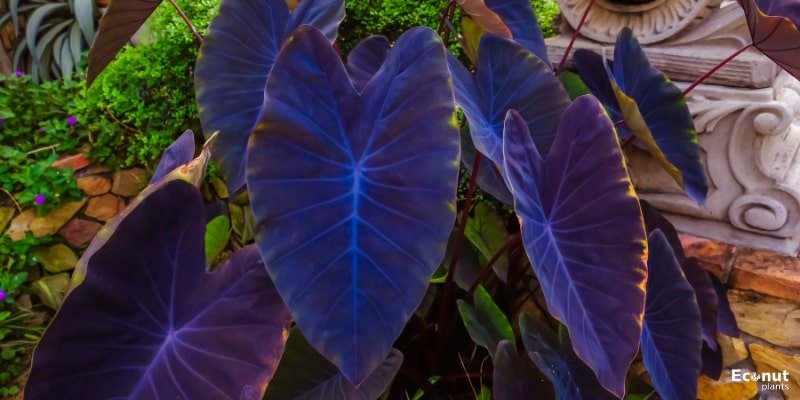
Botanical Name: Colocasia esculenta ‘Black Magic’
Plant Type: Bulb
Sun Exposure: Full sun to Partial shade
Water Needs: Medium
Elephant ear plants can withstand winter in zones 7 through 10, but if you live in a colder area, you can dig the bulbs and bring them inside for the winter. Growing these fascinating plants in a semi-shaded spot is well worth the effort.
Massive, heart-shaped leaves that vary in colour from green with purple veins to completely dark burgundy with a hint of green are produced by the “Black Magic” elephant ear.
Rich, wet, and well-drained soils are ideal for their growth. Elephant ear plants are grown mainly for their distinctive foliage; they have little flowers.
Conclusion
Many plants have purple foliage if purple is your colour of choice! Trees, shrubs, perennials, annuals, and houseplants with purple leaves are among the options available to you.
To get the most visual appeal throughout the year, mix and match different leaf shapes, sizes, and colours in your environment. Enjoy multicoloured gardening with friends and family. Share! Many of the plants on this list are simple to grow!

